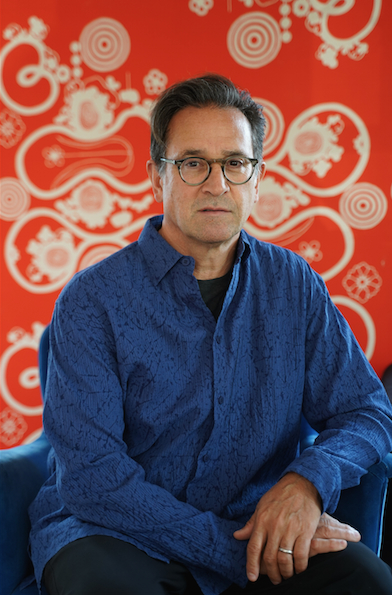Industry Talk
A sense of purpose
by Iain Akerman
October 3, 2024
.jpg) Advertisement
AdvertisementTwo conflicting opinions related to the nature of advertising emerged from this year’s Dubai Lynx. In the red corner stand those who believe advertising is about driving growth. That agencies promote products and services to achieve a singular aim – to sell more goods. In the blue corner stand those who believe brands and their agencies have a far greater role to play in society. That purpose-driven advertising builds deeper connections with consumers, differentiates a brand, and contributes to positive social change.
For the former, brands are not altruistic; they are businesses with the primary objective of increasing profits and satisfying their shareholders.
In ArabAd’s review of the Lynx, Manuel Bordé, VML’s global chief creative officer for commerce, says it is the role of agencies to create “brand work that reverts to its core purpose: selling and transforming businesses”. He is far from alone. Asad ur Rehman, chief executive of So&So Partnerships, believes “brands create communication with one, and only one objective: to sell more in the short or long term”. According to David Fregonas, Accenture Song’s Middle East lead, it is also brand-centric endeavours that “underscore the industry’s dynamism and creativity”.
For the latter, positive social change can encompass everything from sustainability and racial and gender equality to social justice, poverty, and body positivity. “The most successful and enduring businesses are a distinctive force for good – there is something emotional and special that propels their growth and draws in both customers and employees,” says Scott Goodson, founder and chief executive of StrawberryFrog. “This guiding force is often referred to as a ‘purpose’. Personally, I prefer the term ‘movement’ because it emphasises the underlying ideas and principles that shape the business, and it is a framework within which you can activate your purpose to the people who matter inside your company and out.”
“If you want your business to thrive in the years ahead, you must get laser-focused on your purpose and make it the heart that beats throughout your entire enterprise.”
--Scott Goodson, founder / CEO StrawberryFrog
Discussions about purpose are nothing new, but the divide between those who believe a brand’s purpose is to maximise profits, and those who yearn for greater meaning, is increasingly noticeable. At the heart of purpose lies the knowledge that brands find themselves under the consumer microscope like never before. Consumers expect brands to reflect their ideas and principles and to be responsible in an era of environmental vandalism and social injustice. Brands know what consumers want. They know they want to lead better lives, to be kinder to the Earth, and to stand up for issues that matter to them. They also know that destructive practices and ethical ambiguity erode trust – and that once trust is lost it is almost impossible to regain. It is these consumers that are a brand’s future buyers.
“When a brand taps into a deeper sense of purpose and activates that through a genuine, cultural movement, it unlocks incredible power,” says Goodson. “It’s no longer just about pushing a product or service – it’s about mobilising people inside and outside the company around a cause that truly matters. Everyone pulling in the same direction, emotionally engaged, with joy and agency in their hearts. And here’s the kicker – the more socially conscious and purpose-driven the movement is, the more it will resonate with the emerging generations of consumers and employees. This younger cohort, raised on social media and global connectivity, is hungry for brands that stand for something bigger than the bottom line.”
“It may seem like a daunting task, but if the brand truly believes in its purpose, it becomes a part of people’s lives.”
--Kalpesh Patankar, chief creative officer, Leo Burnett Middle East
Agreeing that purpose is a good thing is the easy part. Getting it right is where brands and agencies come unstuck – and leads to calls for brand-centric work. Purpose has to be within the DNA of a brand, not plastered on to win awards or to profit from some célèbre. “A brand’s purpose should be grounded in its ethos,” says Kalpesh Patankar, chief creative officer at Leo Burnett Middle East. “It must be something that guides the people who work for the brand, resonates with the people who interact with the brand, and makes a difference to the lives of the people who buy the brand. It may seem like a daunting task, but if the brand truly believes in its purpose, it becomes a part of people’s lives.”
Patankar points to Homecentre as an example. The company’s purpose is to enable every home to tell its own unique story, whether that story be socially acceptable or not. With ‘The Creature’, it looked at the role of stepfathers, who play a huge part in making a broken home whole again. “It is a topic that is rarely discussed in the region,” explains Patankar. “It started with a film but then went on to cover the bigger topic of remarriage, how stepfathers adjust to new families, and the positive psychological impact of having a stepfather on kids.” The brand has also run campaigns around adoption and single motherhood.
Globally, clothing brands such as Patagonia and Finisterre have placed sustainability at the heart of their brand identities. Patagonia’s ‘Don’t buy this jacket’, which discouraged unnecessary consumption, is a classic of purpose-driven advertising. Dove’s ‘Real Beauty’ focused on promoting body positivity and challenging traditional standards of beauty, while Nike’s ‘Dream Crazy’, featuring Colin Kaepernick, supported social justice and the fight against racial inequality. Ben & Jerry’s has been vocal on a number of issues, including racial justice and LGBTQ+ rights. The ice cream manufacturer was (at the time of writing) one of the only international brands to have called for a permanent and immediate ceasefire in Gaza.
Regionally, much of what is identified as purpose is in fact corporate social responsibility (CSR), although Karen Kamel, regional managing director at McCann Health Middle East, believes the majority of healthcare communication is purpose-driven, simply because it is “trying to create awareness, bring about change in behaviour or change perceptions and bust myths”. She cites the example of McCann Health’s ‘Mis(s)Diagnosed’ for Organon, which highlighted the “shockingly large gender data gap in the diagnosis of women’s cardiac conditions.” In doing so, it revealed the lesser know symptoms of heart attack in women.
“You can often tell when a brand’s alignment with a cause feels forced or insincere.”
--Karen Kamel, regional managing director, McCann Health Middle East
For Goodson, purpose is “not a marketing slogan, it’s not cause marketing, it’s not CSR, it’s not any of that. It’s the essence of the business that is embraced by everyone, including the top, and everything they do in the business is about amplifying that. And that’s the tough part – I think there are a lot of examples of businesses that start to get it right and then it all falls apart.” This failure is often the result of what Goodson calls the ‘purpose gap’ – the distance between a grand purpose proclamation by management and the actual lived understanding and application of that purpose by frontline staff, be it 18 months or three years down the line.
This gap is just the beginning of the difficulties facing purpose. As Goodson suggests, CSR and cause marketing are often mislabelled as purpose, while some brands attach themselves to causes (especially sustainability) in a superficial or opportunistic manner. Rather than a cause being integrated into a company’s core business strategy and reflecting long-term commitment, it is stuck on to attract consumers who value brands that contribute to societal good. Although Patankar believes people are “smart enough to differentiate between brands that hop onto the purpose train” and those that “are actually doing something meaningful to bring about positive change,” that doesn’t stop the flurry of awards entries every year.
“Authenticity is key in purpose-driven advertising,” says Kamel. “You can often tell when a brand’s alignment with a cause feels forced or insincere. Brands that jump on the purpose-driven bandwagon without a genuine commitment to the cause can risk facing backlash from consumers who value authenticity and transparency. To truly resonate with audiences and make a positive impact, brands should ensure that their involvement in social or environmental causes is truly aligned with their values.”
It’s easy to be cynical about these things. The most important factor fuelling brands’ collective charge towards sustainability, for example, is not moral obligation but the bottom line. After all, there’s nothing quite like the threat of financial loss to fast-track a company’s environmental conscience. “At the end of the day, these are businesses, and their primary motivation is to maximise profits and shareholder value,” admits Goodson. “But… the logic is pretty simple. If their consumers and the planet they depend on thrive, then the brands themselves will be able to thrive in the long run.”
In too many cases, however, consistency and transparency are absent, while the use of deceptive marketing to promote the perception of an organisation’s positive environmental stance (commonly known as ‘greenwashing’) is rampant. According to the NewClimate Institute’s Corporate Climate Responsibility Monitor, which was published in April this year, the climate strategies of 11 of the 20 major companies analysed by the report were found to be of low or very low integrity. These companies, all of which have put themselves forward as climate leaders, include Adidas, Nestlé, Tesco, Toyota, and Volkswagen. A further seven companies, including Nike and Volvo, were found to be of moderate integrity. No companies achieved the highest ranking. Social washing and pinkwashing are also liberally applied.
“Any hint of inauthenticity, any whiff of purpose-washing or virtue signalling, and you can kiss your purpose-driven dreams goodbye,” says Goodson. “Consumers these days aren’t going to fall for that smoke and mirrors nonsense. And they’re just waiting for you to not do what we say. No, what you need to do is dig deep, do the hard work of uncovering your brand’s true north star, its reason for being. What difference are you here to make in the world? What are the core values and aspirations that drive you? Get that right, and you’re cooking with gas.”
Belief in the ability to create meaningful social or political change, however, can come undone pretty quickly. While a heightened social and political arena has led to brands speaking out about serious issues, they remain (regionally at least) noticeably quiet when it comes to LGBTQ+ rights and the war in Gaza (see separate article). Such silence undermines a company’s commitment to equity, freedom, and justice, although Goodson believes “very few brands should lean into politics.” Politics, after all, carry the very real risk of backlash, customer alienation, and long-term reputational damage. It is for these reasons that brands and their agencies, in general, stick to what is effectively harmless or, as the former DDB Middle East CEO Hubert Boulos says, “less controversial”.
The benefits of doing so are well documented. According to a Deloitte study from 2021, 57 per cent of consumers globally indicated that, in general, they are more loyal to brands that commit to addressing social inequities.
StrawberryFrog and research firm Dynata’s multi-year empirical study, the Purpose Power Index, has also found that companies with a well-defined purpose (one that is actively operationalised both internally and externally) are growing at astonishing rates, often in excess of 400 per cent. “The evidence is undeniable. If you want your business to thrive in the years ahead, you must get laser-focused on your purpose and make it the heart that beats throughout your entire enterprise,” says Goodson. “Anything less simply won’t cut it in today’s purpose-driven landscape.”
Despite the challenges?
“Look, I have played with purpose for a long time, as have my colleagues at StrawberryFrog,” replies Goodson. “Purpose is a delicate balancing act. But get it right, and the payoff is huge. These conscious consumers, they’re hungry for brands that stand for something bigger. Nail that authentic, purpose-driven approach, and you’ll be sitting pretty.”



.jpg)










